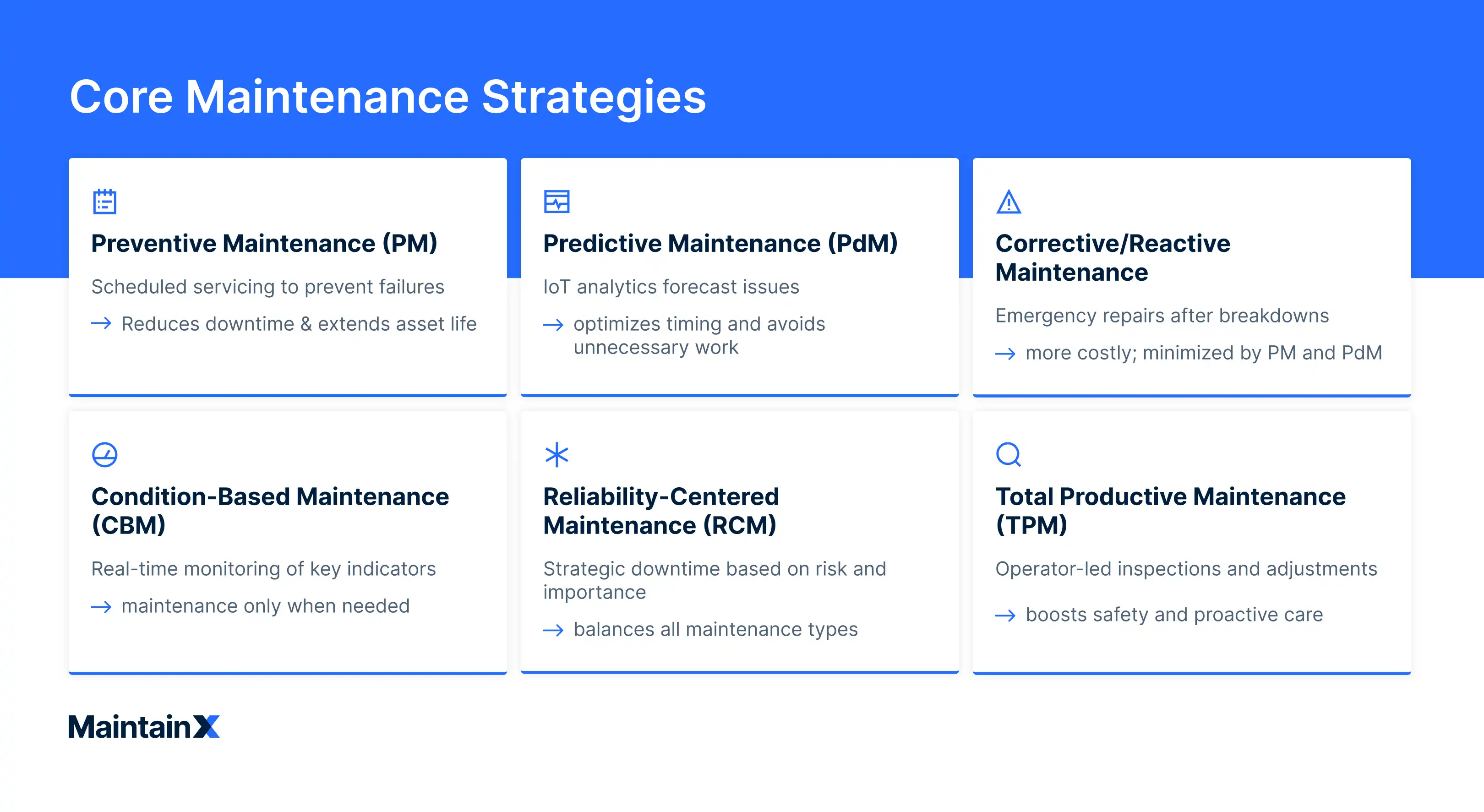.webp)
Asset maintenance management keeps critical equipment reliable, safe, and cost-efficient. It is the first line of defense against unexpected downtime and the delays, costs, and stress that come with it.
In a large or multi-site facility, managing all the moving pieces that go into asset maintenance requires a high level of visibility into your equipment and operations.
The good news for maintenance, repair, and operations (MRO) professionals is that with modern tools like computerized maintenance management systems (CMMS), IoT sensors, and predictive analytics, it’s easier than ever to track and manage assets in a way that’s data-driven and cost-effective.
In this guide, we’ll cover the basics of asset maintenance management: how it works, what it involves, and what you can do to improve your own asset maintenance management program.
Key takeaways
- Asset maintenance management ensures critical equipment performs reliably, minimizing downtime and repair costs.
- Preventive, predictive, and corrective maintenance are the three main approaches organizations use to manage assets.
- Best practices include centralizing asset data, building proactive maintenance schedules, and using analytics for continuous improvement.
- A CMMS streamlines workflows, improves visibility, and helps companies scale from manual processes to data-driven asset management.
What is asset maintenance management?
Asset maintenance management is the process of organizing, scheduling, and monitoring the upkeep of physical assets such as machines, vehicles, and infrastructure. The benefits of this are obvious: Well-maintained equipment will be safer, more efficient, more reliable, and more cost-effective to run.
According to a Deloitte study, unplanned downtime costs industrial manufacturers an estimated $50 billion annually, with equipment failure accounting for almost half of those losses. Strong maintenance practices help organizations avoid these costs and ensure compliance with safety and quality standards.
In practice, asset maintenance management combines data-driven predictive maintenance, streamlined, cost-effective preventive maintenance, and minimal reactive maintenance.
What are the main types of asset maintenance management strategies?

Preventive maintenance
Preventive maintenance (PM) is a concept that should be familiar to any MRO professional: regular, scheduled servicing that keeps equipment in good condition and minimizes the risk of unplanned downtime. A report from Plant Engineering found that 80% of facilities use preventive maintenance as their primary strategy.
Effective preventive maintenance is more nuanced than following OEM guidelines. It requires a high degree of professional judgment to maintain uptime while preventing costly over-maintenance and premature parts replacement. Maintenance leads use their skills and experience to plan PM schedules based on the unique conditions of their facility.
Predictive maintenance
While preventive maintenance largely follows time- or usage-based schedules, predictive maintenance (PdM) uses data analytics, machine learning, and historical trends to forecast when a failure is likely to occur. Instead of waiting for thresholds to be exceeded, PdM predicts the remaining useful life (RUL) of a component and schedules intervention proactively.
For example, sensor data may flag that a motor bearing is trending toward failure, allowing you to schedule proactive maintenance during planned downtime.
According to McKinsey, predictive maintenance can reduce machine downtime by 30–50% and extend equipment life by 20–40%. For asset-intensive industries, this translates into millions in savings annually.
Corrective/reactive maintenance
Corrective, or reactive, maintenance is performed after a failure occurs, when equipment breaks down unexpectedly and must be repaired or replaced to restore operations. While every facility relies on some level of corrective maintenance, overreliance can lead to costly downtime and disrupted production schedules. Emergency repairs are also typically 3–5x more expensive than planned interventions.
Most manufacturers aim to minimize corrective maintenance by prioritizing preventive and predictive strategies.
Condition-based maintenance
Condition-based maintenance (CBM) uses real-time asset data to determine when maintenance is required. Instead of following fixed schedules, technicians act only when indicators such as vibration, temperature, or pressure cross predefined thresholds. This approach lets you reduce unnecessary servicing while intervening before performance and safety are compromised.
Reliability-centered maintenance
Reliability-centered maintenance (RCM) involves identifying the most effective maintenance strategy for each asset based on its function, failure modes, and impact on operations. Rather than applying a one-size-fits-all approach, RCM helps organizations prioritize maintenance for the most critical equipment and balance preventive, predictive, and corrective tactics accordingly.
Total productive maintenance
Total productive maintenance (TPM) emphasizes shared responsibility for equipment care across the entire workforce. Instead of maintenance being the sole responsibility of technicians, TPM engages operators in routine inspections, cleaning, and minor adjustments to keep equipment running smoothly. This proactive approach gives operators ownership of equipment health, leveraging their unique understanding of the machine to identify and troubleshoot latent issues before they lead to downtime.
Importance of asset maintenance management
Beyond avoiding downtime, effective asset maintenance management is also about building resilience and adaptability into operations. Having well-maintained equipment helps you respond faster to shifting production demands, maintain compliance with safety and environmental standards, and extend the useful life of capital-intensive assets.
Over time, this lowers total cost of ownership and frees up resources that you can reinvest in innovation, capacity growth, or workforce development.
Best practices for effective asset maintenance management
Unplanned downtime costs industrial manufacturers $50 billion annually, with nearly half of those losses tied to equipment failure. Best practices for effective asset maintenance management include:
Centralize asset data
Disorganized standard operating procedures (SOPs) and service records are a major barrier to effective asset maintenance management. Centralizing equipment histories, manuals, warranties, and past work orders, ideally in a CMMS, gives teams full visibility into asset performance. This reduces duplicated effort and helps you make smarter repair-or-replace decisions.
What this looks like in practice
A pharmaceutical manufacturing plant has consolidated all equipment manuals, calibration records, and historical work orders into a CMMS. When a tablet coating machine begins showing intermittent errors, technicians quickly access past service logs, part specifications, and maintenance notes, enabling faster troubleshooting and reducing production delays.
Implement maintenance scheduling
Even the best maintenance plans are ineffective if technicians aren’t carrying out tasks consistently. Effective asset maintenance management requires scheduling preventive work, assigning work orders, tracking completion, and automating recurring tasks.
This creates accountability and lets technicians focus on execution rather than managing paperwork or remembering schedules.
What this looks like in practice
A food processing facility has automated maintenance for its high-speed packaging lines. Each week, a CMMS generates work orders for lubrication tasks, belt inspections, and safety checks. Tasks are automatically assigned to the right technicians and tracked for completion. If a work order is missed or overdue, the system escalates it, ensuring nothing slips through the cracks and all assets receive consistent care.
Use data for continuous improvement
Data-driven KPIs such as mean time between failures (MTBF) and mean time to repair (MTTR) help MRO teams identify gaps in strategy. Over time, analyzing trends helps you move toward predictive approaches and refine PM schedules for maximum efficiency.
What this looks like in practice
A metal fabrication shop tracks MTBF and MTTR for its hydraulic presses. Analysis reveals that certain presses fail more frequently during peak production months. Using this insight, the maintenance team adjusts inspection schedules and implements targeted staff training, gradually reducing unplanned downtime and improving overall equipment effectiveness.
Real-world examples of asset maintenance across industries
Effective asset maintenance management looks different across industries, but the goals are the same: maximize uptime, extend equipment life, and reduce operational costs.
Here are some examples of how MaintainX users in the manufacturing, facilities management, and utility sectors have implemented data-driven asset maintenance management strategies.
Manufacturing
In manufacturing, uptime and throughput are critical. Effective asset maintenance management focuses on maintaining consistent production quality while keeping operating costs low.
Cardinal Glass LG implemented predictive maintenance across its production lines using IoT sensors to monitor machine vibration and temperature. This approach helped the company reduce unplanned downtime by approximately 60%.
Facilities management
Hospitals, universities, and large office campuses need to keep HVAC systems, elevators, and utilities in a state of good repair. Asset maintenance management ensures reliability, safety, and compliance while minimizing costly emergency work.
Villages Golf and Country Club significantly reduced the frequency of emergency service interventions by overhauling its inefficient maintenance processes. The community’s asset maintenance management program boosted maintenance team productivity by 27% and reduced reactive work by 30%.
Utilities and energy
Utilities and energy providers operate under high regulatory pressure and must maintain reliable infrastructure. Maintenance management in this sector focuses on preventive care, regulatory compliance, and maintaining service to mission-critical systems.
Southeast Power launched a preventive maintenance program across more than 1,000 assets, establishing standardized procedures and tracking work orders. The effect was transformative: Southeast Power went from “organized chaos” and “putting out fires” to a highly efficient operation with minimal downtime.
Using a CMMS for asset maintenance management
A CMMS is the backbone of modern asset maintenance strategies. It centralizes data, streamlines workflows, and integrates with IoT and enterprise systems.
Two questions often come up when evaluating CMMS platforms:
What features should I prioritize when selecting a CMMS for asset maintenance?
When choosing a CMMS, look for features that support both short-term efficiency and long-term scalability.
How long does it take to transition from manual processes to a CMMS-driven asset maintenance strategy?
The transition timeline depends on the size and complexity of your operation. Smaller organizations can be fully onboarded in a few weeks, while large, multi-site enterprises may take several months to digitize records and train staff.
Most companies begin seeing ROI within six to 12 months, thanks to reduced downtime, better scheduling, and improved labor productivity.
How to get started with asset maintenance management
For organizations beginning their journey, the first step is to document all critical assets and current maintenance practices. From there, prioritize preventive maintenance, adopt a CMMS to centralize data, and gradually incorporate predictive technologies. Over time, this structured approach will reduce downtime, extend equipment life, and lower costs.
Visit our Asset Management page to learn how customers such as DHL and Volvo are reducing equipment downtime with MaintainX.
FAQs
What is the difference between preventive, predictive, and corrective maintenance in asset management?
Preventive maintenance is scheduled work done to avoid failures; predictive maintenance uses data and analytics to forecast problems before they happen. Corrective maintenance takes place after a breakdown has already occurred.
Each plays a role in asset management, but industry data shows preventive maintenance is the most common strategy (used by 80% of facilities). As facilities become more connected and data-driven, more MRO teams are using predictive maintenance to reduce downtime and lower labor costs.
How does asset maintenance management improve equipment reliability and reduce downtime?
Asset maintenance management ensures equipment is serviced on schedule, monitored with performance data, and proactively repaired before issues escalate. This reduces unexpected breakdowns, improves reliability, and extends the lifespan of capital-intensive assets.
For example, Cardinal Glass LG reduced unplanned downtime by ~60% after implementing a predictive maintenance program, demonstrating how effective strategies can directly improve uptime and productivity.
How can digital tools like IoT sensors and AI improve asset maintenance planning?
IoT sensors track real-time data such as vibration, pressure, and temperature, while AI analyzes these trends to forecast failures and recommend interventions. This enables teams to move from fixed schedules to condition-based or predictive strategies, focusing resources where they’ll have the most impact.
According to a McKinsey study, companies that adopt predictive analytics can reduce maintenance costs by 10–20% while cutting machine downtime by up to 50%, highlighting the significant ROI of digital tools.
Which industries benefit the most from structured asset maintenance management programs?
Any asset-intensive industry, such as manufacturing, utilities, energy, and facilities management, can benefit from structured maintenance programs.
Manufacturers rely on asset management to maximize throughput and avoid costly line stoppages, while utilities depend on preventive care to maintain regulatory compliance and service reliability. Facilities such as hospitals, campuses, and residential communities all benefit from improved safety and comfort and reduced emergency repairs.










.webp)
.png)